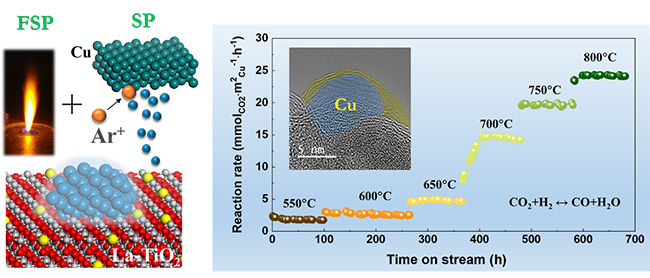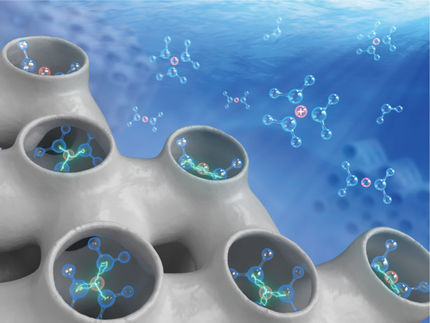Scientists create ultra-highly stable Cu-based catalysts
The development of Cu-based catalysts is limited due to their poor thermal stability caused by the low Tammann temperature of Cu.

Ultra-highly stable Cu/LaTiO2 heterogeneous catalyst at 800°C
YU Jiafeng
Recently, a research group led by Prof. YU Jiafeng and Prof. SUN Jian from the Dalian Institute of Chemical Physics (DICP) of the Chinese Academy of Sciences (CAS) constructed an ultra-highly stable Cu-based heterogeneous catalyst at high temperatures by constructing classical strong metal-support interactions (SMSIs).
This study was published in Nature Communications on Dec. 10. Prof. Noritatsu Tsubaki from Japan's Toyama University and Prof. LIU Yuefeng from DICP were also involved in this study.
The researchers combined two unique technologies, magnetron sputtering (SP) and flame spray pyrolysis (FSP), to reconstruct the electronic structure of metallic Cu and the reducibility of the TiO2 support, respectively.
They created the classic SMSI on non-noble metal Cu-based catalyst at mild reduction temperatures for the first time, and realized controllable preparation of ultra-highly stable Cu-based catalyst. This catalyst exhibited ultra-stable performance for more than 500 hours at 600 °C. The sintering of Cu nanoparticles was effectively suppressed even at 800 °C.
Moreover, the strength of SMSI could be effectively controlled not only by reducing temperatures as before but also by tailor-made Cu via sputtering power regulation or decorated supports for rational catalyst design on demands.
"We expect that our new findings will serve as a general guide to design a highly stable heterogeneous catalyst at a wider range of temperatures," said Prof. SUN.
Original publication
Original publication
Yu, J., Sun, X., Tong, X. et al.; "Ultra-high thermal stability of sputtering reconstructed Cu-based catalysts"; Nat Commun; 12, 7209 (2021).
Organizations
Other news from the department science

Get the chemical industry in your inbox
By submitting this form you agree that LUMITOS AG will send you the newsletter(s) selected above by email. Your data will not be passed on to third parties. Your data will be stored and processed in accordance with our data protection regulations. LUMITOS may contact you by email for the purpose of advertising or market and opinion surveys. You can revoke your consent at any time without giving reasons to LUMITOS AG, Ernst-Augustin-Str. 2, 12489 Berlin, Germany or by e-mail at revoke@lumitos.com with effect for the future. In addition, each email contains a link to unsubscribe from the corresponding newsletter.
Most read news
More news from our other portals
Last viewed contents

Water is an active element in proteins - Bochum’s researchers discover proton diode
Tunable peptide emulsifiers discovered

Two new ways to fluorinated structures - Chemo-enzymatic synthesis of fluorinated antibiotics
Sensient_Technologies_Corporation
Curie_point
Category:Neutron_instrumentation
I._M._Dharmadasa




























































